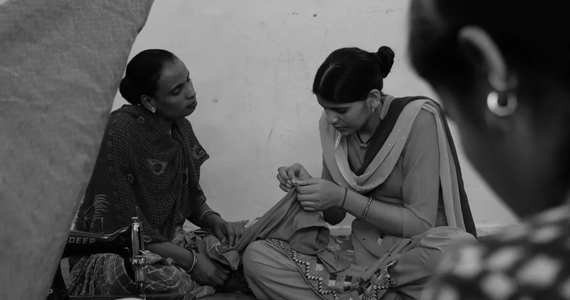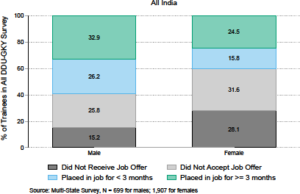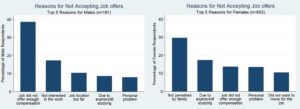Making Skill India Work for Women

By now, the facts of Indian women’s labor market participation that should be jarring have become rote: Indian women, particularly rural women, have dropped out of the labor force in a period of strong economic growth; Indian women’s labor force participation rates are lower than all other G20 countries outside of Saudi Arabia; and the latest Labour Force Surveys suggest that, even at less than 24% overall1, female labor force participation continues to decline.Frequently, Skill India is mentioned as a means of altering this pattern for young women by bringing them into the workforce. Such skilling programs can give women useful training and directly connect them with employers who are eager to hire them. The most recent NSS employment data (2011-12), suggests that young, unmarried women are a particularly high potential group: they have very low labor force participation rates, but report relatively high interest in working—32% of respondents in rural areas and 28% of respondents in urban areas who were out of the labour force reported willingness to work (Pande, Moore, & Fletcher, 2017). Data from a small survey we conducted with skills trainees in Madhya Pradesh further substantiates this: women were less likely to be working than men, but unemployed women and men reported similar levels of job search, even for jobs that required migration2.While skilling provides substantial opportunities for young women’s economic empowerment, constraints to women’s participation in such programs abound. In a context where income- generating opportunities are absent for women, norms have emerged that reinforce this exclusion and impose substantial barriers to women’s entry. Even when quotas for women’s participation in skilling programs exist, our research has highlighted the myriad of challenges women face to join skilling and then in translating this skilling into a longer-term employment opportunity. In a survey of 2,610 former skilling trainees, we see a clear leaky pipeline for women. Women are less likely to receive job offers at the end of skilling, highlighting potential discrimination. On the supply side, female trainees are also less likely to accept job offers they do receive (see figure 1). Contrary to common expectation, women that join jobs are just as likely to stick with them as men. While this provides some scope for optimism, all trainees report disappointing employment outcomes overall: one year after skilling, only 1 in 5 former trainees still earned an income.

So what keeps women from joining skilling and remaining in jobs? Our research to date, which has included a small survey in central Madhya Pradesh of potential trainees and their parents3, a phone survey of former skilling participants from seven major states, and analysis of administrative data from Odisha, a top skilling performer, point to several clear constraints to women joining skilling:
First, women’s skilling and labor force decisions are made in consort with, and typically with permission from, family members. These coordinated decisions often inhibit women’s ability to take-up skilling and employment. Despite women wanting to work at high rates, male family members often retain more gender-biased attitudes towards women’s work: from our small survey in Madhya Pradesh 31% of fathers and 42% of male youth did not believe that women should go out to work. In our phone survey of former trainees, the top reason women reported not accepting a job was that their family did not give them permission to do so (see figure 2).
Males, in contrast, most frequently declined jobs because of dissatisfaction with compensation. Similar dynamics were reported with respect to leaving post-skilling employment, where women dropped out as a result of family pressure and men dropped out principally because of job-related dissatisfaction.

Second, with the growing demand for skilled work in urban cities, migration raises major concerns about safety for both women and their families. In a small survey of training-eligible youth in central Madhya Pradesh, 69% of females reported it is unsafe to live away from home even during training, compared to 31% of males. Male guardians also overwhelmingly report they believe crime is more likely to happen in urban areas than the village (85%), and both violent and non-violent crimes are more likely to happen to women (84% and 86%, respectively), suggesting they would be relatively more concerned for their female family members’ safety post-migration than males’. These concerns, due to the influence of family members on girls’ employment decisions, have limited women’s take-up of skilling – when women are offered jobs outside their district and state, their job acceptance rates decline. The same does not hold for males.
Third, potential trainees seem to have inaccurate expectations regarding their wages in jobs post- skilling, which may limit the perceived value of skilling for women. This discrepancy is clearly a barrier for males’ skilling success, but may also keep family members from allowing women to accept job offers after skilling. In our survey of potential trainees in rural Madhya Pradesh, male youth reported they would need to earn 13,827 INR per month to accept a job in Bhopal and women report they would need to earn 12,231 INR per month. These reservation wages nearly double when considering migration to Delhi: male youth report that they would need to earn 26,788 INR per month to relocate to Delhi and female youth require only 20,740 INR per month on average4. In reality, the average monthly salary offered to DDU GKY trainees for jobs in Delhi is 7,800 INR and 6,550 INR in Bhubaneshwar.
These three critical facts pointed our research team to the importance of two crucial pieces of the female skilling and employment puzzle: First, given high leakage along the “skilling pipeline”, it is necessary to identify which women are most interested and likely to take up training, accept jobs, and remain in employment prior to investing in training them. Second, to involve women in skilling and employment, families need accurate information and support help them feel comfortable giving women permission to join skilling. To address these issues, our team at EPoD India at IFMR, along with researchers from Harvard and Oxford, is working with the state of
4 In contrast, average monthly wages for the youth who were employed was Rs. 8,771 for male youth and only Rs. 1,527 for female youth.
Odisha to test whether local self-help group (SHG) leaders can better identify willing women workers (and supportive families), and provide potential trainees and their family members with information to encourage women to take up skilling.
The theory of change behind such an approach assumes that SHG leaders have networks that will be able to identify willing trainees. They will have an insider’s perspective on which potential candidates will be successful since they can screen for characteristics related to labor market success –a family’s need or even potential participants’ individual traits – in ways that a recruiter from outside the village cannot. These local leaders are likely also well-connected to potential trainees’ families and can serve as an important liaison between training centres, employers, and the government.
Our project takes place across 317 Gram Panchayats in Ganjam and Nayagarh districts in Odisha. Through an RCT, we study Odisha’s SHG-linked recruitment model. We compare SHGs across three groups: In some randomly selected areas, training centers recruit participants using traditional methods of sending center staff to rural villages. The two other randomly selected groups employ the SHG-linked recruitment approach, where local female SHG members recruit trainees instead of training center staff. These two groups differ in terms of the training they received – one group of SHG recruiters received the standard training and the other group received additional information on male and female trainees’ employment prospects in different locations, and potential wages across locations. This additional information we hope will help equip these leaders with more accurate information to share with families about young women’s employment prospects post training. While the study is on-going through 2019, we are optimistic that this study will help us understand both the efficacy of the SHG-linked recruitment model, as well as to identify strategies to address some of the barriers that still keep women from benefitting fully from Skill India.
Charity Troyer Moore is the India Research Director for Evidence for Policy Design at the Harvard Kennedy School. She leads research-policy engagements with a variety of entities in India to ensure that research is attuned to the problems facing policymakers and integrated into policy design and program implementation.
Soledad Prillaman is a Postdoctoral Prize Research Fellow in Politics at Nuffield College at the University of Oxford. Her research interests lie at the intersections of comparative political economy, development, gender, and the politics of the welfare state, with a focus in South Asia
Sources:
Artiz Prillaman, Soledad, Rohini Pande, and Charity Troyer Moore. “Can Skill India Help Rural Women Integrate into the Labor Force? Learning from a Successful State.” 2018. Draft working paper prepared for the International Growth Centre.
Artiz Prillaman, Soledad, Rohini Pande, Vartika Singh, and Charity Troyer Moore. “What Constrains Young Indian Women’s Labor Force Participation? Evidence from a Survey of Vocational Trainees.” 2017. Available here.
Evidence for Policy Design and IFMR. “Women and Work in India: What do we Know?” 2016. Policy Brief.
Pande, R., Moore, C. T., & Fletcher, E. K. (2017). Women and Work in India: Descriptive Evidence and a Review of Potential Policies. CID Working Papers 339.
- Posted In:
- Latest Blogs


















































Leave a Reply